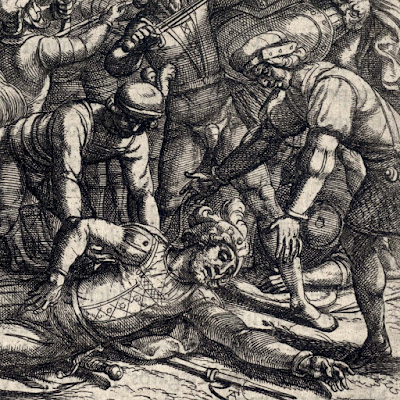Antonio
Tempesta (1555?–1630)
“The Roman Misled by Civilis’ Horse that He was Dead or Injured”
(TIB title), 1611/12, possibly after Otto
van Veen (1556–1629) (according to the Rijksmuseum [see RP-P-OB-37,689),
plate 17 from the series of 37 plates (including the frontispiece/titlepage),
“The War of the Romans Against the Batavians” (Romanorvm et Batavorvm
societas), published in the first edition (1612) with Latin letterpress text
verso illustrating Tacitus, "Histories", IV, 24.
Inscribed on the plate with the artist’s monogram within the image
borderline: (at lower right on the weapon blade) “AT”.
Lettered below the image borderline: (in five lines of Dutch text
at left) “Het secours naer by synde, de belegherde vallen wt, Civilis / valt
met syn peerdt, waer door de Romeynen moet grypen, / meynende dat hy doodt oft
ghequetst was. De Hollanders / vervaert zynde, vluchten, ende laten het secours
in trecken.”; (center within a circle) “17”; (in five lines of Latin text at right)
“Cum auxiliary haud procul abessent, obsessi portis erumpunt. / Civilis lapsu
equi prostratus, creditus aut vulneratus aut / interfectus, multum suis pavoris
et hostibus alacritatis / dedit. Batavi fugientes, legiones ingredi Vetera
permittunt.”
(Google transl. “When the auxiliary position not far from a
distance, might, in the siege the gates of the break out. / Civil horse slipped
down, or believed to be wounded / killed during much of its incredible panic /
her. Of the Dutch, having escaped, they allow the legions to enter the Old
Camp.”
Etching on laid paper trimmed to the image borderline and backed
with a support sheet.
Latin text on verso.
Size: (sheet) 16.5 x 21.1 cm
State i (of ii) Note: TIB lists this impression as “SI II” and the
impressions without the Latin text verso as “SI I2”. In the second state the
plate is “heavily retouched” and with “PLANCHE XVII / CIVILIS RENVERSÉ DE
CHEVAL” lettered above the image borderline (amongst other changes).
TIB 35 (17).576 (145) (Sebastian Buffa (ed.) 1984, “The
Illustrated Bartsch: Antonio Tempesta: Italian Masters of the Sixteenth
Century”, vol. 35, Abaris Books, New York, p. 305); Bartsch
XVII.145.576 i/ii (Adam von Bartsch 1803, “Le Peintre graveur,” Vienna); Nagler
XVIII.179.560-.595 (G K Nagler 1835–52, “Neus allgemeines Künstler-Lexicon” [22
vols.]).
See also the description of this print at the Rijksmuseum : http://hdl.handle.net/10934/RM0001.COLLECT.183688
Condition: superb early impression from the first state that is richly
inked, crisp and well-printed with Latin letterpress text from verso faintly
visible recto (as is appropriate and expected for a print from this early
edition). (Note: to appreciate the quality, compare this impression with the one
held by the Los Angeles County Museum of Art (LACMA): https://collections.lacma.org/node/234370).
The sheet is in near faultless condition (i.e. there are no tears, holes,
folds, abrasions, stains or foxing), trimmed to the image borderline and backed
with a support sheet of archival (millennium quality) washi paper.
I am selling this strong lifetime impression of this magnificently
etching—note the almost looming presence of the castle portrayed at the top of
the composition and the very beautiful treatment of Civilis’ rearing horse
(especially its mane and tail!)—for the total cost of AU$195 (currently US$147.87/EUR121.89/GBP107.33
at the time of posting this) including postage and handling to anywhere in the
world.
If you are interested in purchasing this near pristine etching from the
early 1600s, please contact me (oz_jim@printsandprinciples.com) and I will send
you a PayPal invoice to make the payment easy.
This print has been sold
When I was piecing together the information that I had found about
this print, I wondered why the Rijksmuseum had added the cautionary note to
their description of the etching that its composition was “possibly” after the
design of Otto van Veen—Ruben’s teacher. I can now report that I understand the
museum’s reticence: according to Eckhard Leuschner’s (2007) in the catalogue
raisonné for Tempesta, “none of the preparatory drawings by Van Veen has come
to light” (“The Illustrated Bartsch, vol. 35, Commentary, Part 2: Antonio
Tempesta”, Abaris Books, p. 103).
Another quandary worrying me was the inconsistency in the date given for the plate's execution: one auction house assigned the date as “1611”, whereas the Rijksmuseum
gave the date, “1612.” Leuschner’s TIB’s account, again laid my mind to rest: “Tempesta must have finished the plates some time (perhaps a
year) before the publication, since the frontispiece … carries the inscription:
‘Ant. Tempest f. Anno 1611” (ibid). Essentially, the print was published in 1612, but it is likely to have been executed a year or so before the date of publication.








No comments:
Post a Comment
Please let me know your thoughts, advice about inaccuracies (including typos) and additional information that you would like to add to any post.